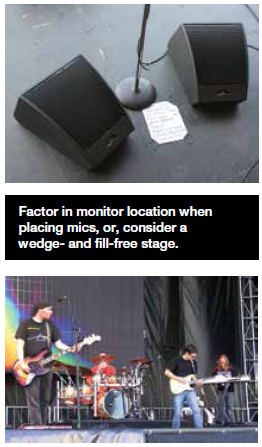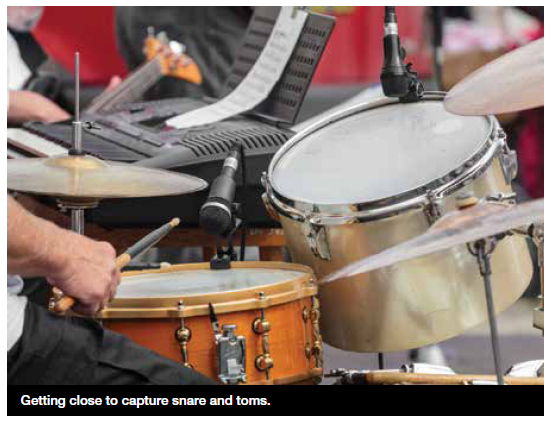
A lot has been written about “correct” mic placement for recording but I follow a simple philosophy.
In sound check, I put on a pair of headphones with a long extension cable, and then with the musicians playing, I move each mic about in different positions. The place where each mic sounds the best to my old ears, and where it most rejects the other instruments and amps, is where it ends up.
After positioning the mics, a quick listen to a test recording confirms if the placements work and it provides the opportunity to ID any trouble spots and make adjustments before the show starts.
With that in mind, here are some of my approaches with microphones for live recording.
Vocals. Depending on the vocalist, I may use either a dynamic or a condenser but the focus is the narrowest pattern I can get away with, depending on the singer’s mic technique. If there are wedges, I try to position them at a 30- to 40-degree angle, which is usually the null zone of the mic’s pickup pattern.
For singers who hold the mic away from their face or down by their belt, I outfit them with a wireless headworn mic positioned near their mouth, or worst case, clip on a lav. The goal is to capture the full vocal between the two mics, which can then be optimized later in the recording mix.
Background/Multiple Vocalists. Many of us tend to use the same mic on every background vocalist so we have an easier job doing monitors. But when recording, I try choose a mic that suits each vocalist’s voice, even if they all end up with different types.
Kick Drum. I have two approaches, depending on the style of music. To capture the attack sound of a drum that has a hole in the front head, I place a large-diaphragm dynamic inside the drum, within 4 to 12 inches of the front head, pointed about halfway between the center of the drum and the rim. This is joined by a boundary flat plate type mic sitting on foam or a pillow inside the drum, which captures more of the shell sound.

Hi-Hat. A small-diaphragm condenser is my “go to” mic, but a dynamic can also work well if it needs to be positioned where there’s a chance it will be hit with a drumstick.
Snare. A single dynamic placed an inch or two away from the head, pointed near the rim, is my live approach. For recording I sometimes place a cardioid condenser a few inches from the bottom head to capture more of the “snap,” tailoring the position based on what I hear.
Toms. Cardioid dynamics are a good choice, but small clip-on condensers designed for drums can work great.
